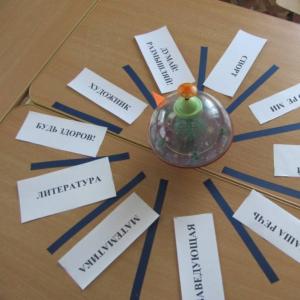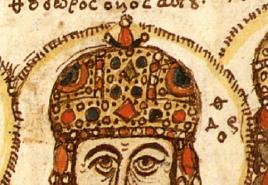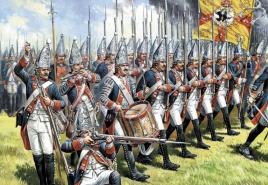Muscovy tit. Muscovy bird. Lifestyle and habitat of the Muscovy bird Muscovy nesting
Appearance.
The dorsal side is gray, the head is black with white cheeks (limited below by black) and the back of the head, the abdomen is light gray without a black longitudinal stripe. The current name “Moskovka” most likely comes from the old name “maskovka”, i.e. tit with a mask on its “face”.
The song is “tsi-pi” or “ti-ti-tyuy”, the cry is a thin “tsit”.
Habitat.
Lives in coniferous, less often dense mixed forests. Rarely visits feeders and almost never flies into populated areas.
Nutrition.
It feeds on insects and prefers spruce seeds in winter.
Nesting sites.
It nests in coniferous forests, mainly spruce, less often in mixed forests.
Nest location.
The nest is placed in hollows of preferably coniferous trees, at a low height (often about 1 m). It often makes a nest in rotten stumps, sometimes between the roots.
Nest building material.
The outer walls of the nest are made of moss and horsehair; internal ones are made of wool, sometimes feathers and cobwebs.
Shape and dimensions of the nest.
The size of the taphole is very small and, as a rule, does not exceed 25-30 mm in diameter.
Features of masonry.
A clutch of 7-11 white eggs with reddish-brown speckles, often forming a rim at the blunt end. Egg dimensions: 14 x 11 mm.
Nesting dates.
Egg laying is observed in late April - early May. Incubation lasts 14-16 days, and feeding of the chicks in the nest lasts 16-17 days. In early June, flight chicks appear. The Muscovy bird hatches chicks twice a summer. The second clutch occurs in June.
Spreading.
Distributed throughout almost the entire forest zone of the European part of Russia, except for northern Siberia.
Wintering. Resident bird.

Description of Buturlin. Moskovka- one of the most little ones representatives of the entire tit family. The length of the male is only about 11 centimeters, and the female is even smaller. This is a fidgety, rather short-tailed bird with somewhat bristly feathers on its head. She is predominantly dark gray and black coloring, but the belly is light, with reddishness on the sides), and the cheeks are bright white. They especially stand out because they are surrounded by black. The head on top and the back of the head on the sides are velvety black. The same bright black coloring is found on the throat and chest in the form of a large shirtfront. There is a white spot on the back of the head. The back, wings and tail are bluish-gray, darker and browner on the flight feathers and tail feathers. There are two white stripes on the wings (from the white spots at the ends of the coverts). The young ones in the nesting feathers are noticeably duller than the old ones (their white areas are yellowish), but they already have all the basic colors of their parents.
Despite its seemingly narrowly local name, Moskovka is widely widespread not only in Russia, but throughout Western Europe, northwestern Africa, Asia Minor and Central Asia. In the European part of Russia, it lives from the Far North (forests of the Kola Peninsula) south to approximately the border of large forests. In the Lower Volga and Ukraine it is found only in autumn and winter, but lives sedentary in the mountains of Crimea, the Caucasus and Southern Siberia (Altai, Sayan, Khingan). To the east, its distribution area extends to the Sea of Okhotsk throughout the taiga of Siberia. In many geographical areas (for example, in the Crimea, the Caucasus, and Asian mountainous regions), Muscovite detects subspecies differences in the degree of reddishness of the lower part of the chest (for example, the red-breasted Kazakhstani subspecies) and the shades of the upper side of the body (Highland Asian ones are darker). In addition, the size of the body and parietal crest is variable.
The distribution of Muscovy in forest areas of Russia depends on its obvious attraction to coniferous species. Old mossy spruce forests with half-rotten hollow trunks of individual deciduous trees are the most favorite habitats these birds. And on the mountains they stay in the coniferous forest zone (in Crimea also in beech groves).
In the Kostroma and Vologda forests you can constantly hear their loud cries of “tyu-pi...” and thin tit whistling. Here and there, these nimble birds swarm around large fir trees, hanging in all sorts of positions from branches and cones, flashing their white cheeks. Together with the kinglets, they scour the trees in search of small ones. insects, mainly weevils, bark beetles and even small hairy caterpillars (birds pluck out their soft insides). In winter, Muscovites do not disdain spruce seeds. Holding the seed between its fingers, the bird, with frequent blows of its small beak, crushes the shell and eats away the contents.
From early spring, loud noises are heard through the forests. songs males - a two- or three-syllable cry, repeated many times in a row. In structure, the song is quite similar to the song of a great tit, but its tone is higher and noticeably more hasty (“tyupi-ti, tyupi-ti, tyupi-ti...” or “cog, cog...”).
eggs
there are up to 10-11 pieces. Their coloring is typically titmouse - with a white main background, densely covered with distinct reddish-brown small spots (the eggs are about 15 millimeters long). Both sexes incubate for twelve to fourteen days, and the chicks sit in the nest for the same amount of time. During the summer, many couples have a second clutch, but no more than 6-7 eggs.
The broods of Muscovites are as noisy and noticeable as those of other tits. Squeak of ten young, a chorus of people begging for food from old people, can be heard from afar. You can get very close to the whole family. Later, in August, individual broods join together, and autumn flocks of Muscovites sometimes reach large sizes. More often, several birds temporarily join wandering flocks consisting of great tits, tufted tits and chickadees. But even in these flocks, Muscovites keep somewhat aloof, preferring, like kinglets, to rummage through coniferous trees and flutter along their tops after the flock.
These tits migrations are more developed, and in some places there is even a real migration in the fall (from August). In winter, Muscovites fly to the steppe Ukraine, and from Siberia to Central Asia. But it’s remarkable that the number of birds varies greatly from year to year. Thus, near the city of Yaroslavl in 1900, 1903, 1904, 1911 there were large autumn migrations, and in 1899, 1907, 1912 - very weak (observations by S. Pashchenko for 30 years). Sometimes the increase in numbers persists for two autumns in a row. Other years (1886, 1891, 1896, 1905) there was no flight at all. Similar fluctuations were observed in the former Tula and Ryazan provinces. These fluctuations are noticeable especially clearly only in the central regions of the European part of Russia and probably depend on local seasonal conditions in the coniferous forests of the northern zone, where the bulk of Muscovites nest. Fluctuations in the number of offspring associated with meteorological and feeding seasonal conditions (summer weather, number of insects) can also determine the number of migrating individuals. However, careful observations in different places are still needed to fully elucidate the causes of this phenomenon.
The Muscovy is the smallest titmouse. Its main difference from its tit sisters is its beautiful voice, which is why they called the Muscovite songbird. The coloring is dominated by dark tones, for which the Muscovy was given another name - black tit. The head is shiny black on top, with a white spot on the back of the neck. Throat black. There are white spots on the back of the head and cheeks, the back is gray, the chest and underside of the body are dirty white, and there is an ocher coating on the sides. The wings and tail are grayish-brown. A light transverse stripe is noticeable on the wings. Males and females are identical in color.
Distributed throughout Russia from the westernmost borders to Sakhalin, Primorsky Krai and Kamchatka. In large cities it is found in parks and forested areas on the outskirts of the city. It is especially noticeable in the city during winter migrations during the years of spruce and pine cone harvest.
The Muscovite lives mainly in spruce or pine forests. She makes a nest in old hollows, in the roots of fallen trees, in the cracks of wooden houses. Not finding a suitable hollow, it also occupies abandoned rodent holes. The nest is constructed from moss and scraps of wool from various animals; the inner layer of the nest always contains cobwebs and downy feathers.

In the summer, when the chicks appear, titmice and other titmice unite in noisy flocks and roam the forest together in search of food. These birds feed exclusively on insects, caterpillars, butterflies, and in winter they consume the seeds of coniferous trees. Muscovy tits love to store supplies, and they hide the caught caterpillar or butterfly on the inside of the branch so that the snow that falls in winter does not interfere with getting to the pantry.
The voice of the Moscow tit:
Your browser does not support the audio element.Text used:
A. Gorkanova. "Migratory and wintering birds of Russia. Thematic dictionary in pictures"
The Muscovy is one of our smallest and nimble tits. Like kinglets, it prefers to stay in the tops of tall coniferous trees, examining the outer parts and terminal branches of the crowns. It probably formed in the dark coniferous (mainly spruce) forests of East Asia with their ancient formations of spruce and fir. The Muscovy's obvious affinity for spruce is clearly evident throughout its vast range from the mountain forests of Southeast Asia to the western coasts of Europe and the Atlas Mountains in Africa. Starting from the primary areas of its birth, it is at the same time closely associated with mountain spruce forests and, in addition to hollows, often nests in crevices and cracks of rocks. The connections between Muscovy and pine are clearly expressed, but less clear. According to a number of characteristics (and most importantly - the song), the Muscovy is very close to the great tit (more precisely, to the group of green great tits). Since the place of primary origin of the group of green tits was also Southeast Asia, this directly indicates that the Muscovy and great tits have common and close ancestors. These connections have been preserved so clearly that both species (great tit and Muscovy) have the same types of songs in their repertoire. The structure of the songs themselves is similar, and the laws of their development are identical. However, even close connections with mountains and spruce still do not allow us to call the Muscovy a northern or even taiga bird, since the northern border of its range in many areas does not reach the northern borders of spruce and is limited only to areas of highly productive and tall spruce forests. Although this pattern is not observed everywhere.
The Muscovy is apparently a very strong, intensively developing, extremely dynamic species. In this respect, it resembles its historical partners in spruce forests - the crossbill and kinglet. All these 3 species are prone to sudden changes in numbers, wide movements and sudden mass flights - migrations. In the case of crossbill-spruce and Muscovy, this is largely due to fluctuations in spruce cone yields. The crossbill has the most powerful migrations and population outbreaks, since its existence directly depends on seed yields. For Muscovy, these connections are weakened, because it depends to a greater extent not on cone yields, but on those pests that in large numbers infect spruce, its cones and seeds. The kinglet’s connections with the spruce are even more indirect, and for him the spruce is more like a substrate on which he collects everything he can find. The number of kinglets is an indicator of the general condition of the spruce forest and its specific entomofauna.
In the vast expanses of its range, the Muscovy is often a sedentary, partially nomadic, and sometimes strictly migratory bird with a pronounced tendency to mass sudden migrations. The Muscovy nests mainly in spruce, less often pine (usually tall-trunk) forests. Avoids spruce and pine young trees. In mixed, deciduous forests and riverine forests, it usually nests only where there are at least single tall spruce trees. Like most sedentary birds, it is prone to massive storage of food and strong preservation of permanent pairs. During non-breeding times, it often stays together and wanders with flocks of nuthatches, chickadees, gennaders, great tits and pikas.
The first signs of spring revival sometimes appear in December - January, but more often in February - March. The height of spring games is in March - early April. These days, Muscovy women not only sing a lot, become very loud and noisy, but often chase each other around tall fir trees. Breeding pairs of Muscovites often form before they appear on the site where they will build a nest. Both birds work together to find a place for a nest and mark the nesting site itself. Old birds, even joining a flock for the winter, do not lose their connections. They also appear in pairs at feeders among other tits when they remain in their nesting area for the winter. And yet many, and sometimes very many, Muscovites migrate far from their usual nesting sites. The further north the birds nest, the more often and regularly they fly away and migrate south for the winter. More often, young birds - fingerlings - go on migrations and long-distance migrations.
In the middle zone, Muscovites begin nesting in mid-April. They usually occupy old hollows of chickadees, less often - small spotted woodpeckers, sometimes they build a nest under the roots of trees, in artificial hollows and even in empty burrows of rodents. In the mountains of Siberia, Central Asia and the Caucasus, where the Muscovy nests, its nests are often found in crevices and cracks of rocks. Muscovy can be attracted to personal plots, gardens and parks, where tall pines and spruce trees grow. Huts for Muscovy must be made from thin stumps of aspen, birch or alder trunks. The Muscovite colonizes spruce and pine nests well with a small (20-30 mm in diameter) entrance, especially if the nests are hung in groups of tall spruce trees. Sometimes the female builds her own hollow, plucking it out in rotten aspen, birch or alder trees, in stumps or in tree trunks fallen to the ground.
At the selected nesting site, especially with a ready-made hollow, the male Muscovy sings a lot and regularly. Unlike other birds, it sings very rarely near the nest and only when mating, courting a female, or accompanying her during feeding or collecting nesting material. At the same time, he often interrupts singing, feeds himself and feeds the female. Feeding the female before mating and the start of laying is of a ritual nature. At the same time, the male lowers his wings, hunches unnaturally, flutters his wings finely and quietly circles, making peculiar buzzing sounds. The female often takes the pose of a chick begging for food and also flutters her wings finely, sometimes taking a spread-eagle pose.
The male usually sings his duty (or working) song far away, often 50-70 m from the nest, sitting on the crown of a tall spruce. It seems to become a kind of beacon, signaling that Muscovites are nesting in this area. The main point of guard singing is chosen at one of the most noticeable places where one can expect the appearance or flight of other Muscovites. The song of the Muscovy, like the song of the great tit, is evolutionarily built on the basis of its calls. The song is not complex, usually includes 2-3 sounds from 2 or 3 types of urges. Sometimes a song sounds even simpler - like a repetition of one urge. Most often, Muscovite songs are conveyed with the following sounds: “cog-cog-cog-cog...” or “tsi-vin... tsvin-tsvin-tsvin”, “tsvin-tsvin-tsvin”, etc. But this is just an elementary simplified diagram. In fact, the vocal repertoire of Muscovite women is very rich. Each bird may have 7-11 distinctly different song types. There are cases when, after several years of life in captivity, Muscovites delighted their owner with a new or even several new songs.
In the middle zone, Muscovites do not really like to nest nearby. The nearest nests are usually located at a distance of no closer than 50-70 m. However, males can sing at their guard posts and 15-20 m from each other. But then they don't sing at the same time. And if this happens, they prefer to be located at opposite ends of their territories. As with many other birds, in such situations, neighboring males may engage in vocal coordination with each other. At the same time, they sometimes choose the same songs from their repertoire and then signal to all other males that birds with related blood have settled here. Sometimes Muscovites enter into a real vocal tournament with each other and then, in the most intricate and unexpected way, they begin to juggle all their songs in front of each other, demonstrating their experience, talent and strength. This is how hierarchical ranks among birds can be established in Muscovite settlements. However, it is extremely rare to find a group settlement of Muscovite women in central Russia. Sometimes Muscovites nest next to great tits (nests can be located very close to each other, 15-20 m). Then the Muscovy often sings in concert with the great tit, and the tit often answers her willingly. The vocal repertoire of a small group of Muscovites or a settlement of 20-30 birds can be very rich. Many birds have both the same and different types of songs (or, more precisely, types of syllables that make up the song). Many birds in such a group may have unusual, rare songs. Thanks to such diversity in the distribution of songs, the general arsenal of song types among Muscovite women in a certain area is often very rich. The vocal repertoires of geographically distant groups (populations) also differ sharply. Certain types of songs have different areas of territory. There are very widespread types of songs with huge areas, and there are classes and types of songs with local areas.
The usual sound signaling system of Muscovites, functioning on the basis of urges, is also complex and varied. Like other tits and kinglets, Muscovites have a very developed system of “qi” signals, which works on an emotional, combinatorial basis. The speed and frequency of reproduction (repetition) of these sounds are determined by the level of emotional arousal of the bird. The signal is emitted calmer, quieter and less frequently - danger or anxiety decreases, more often - increases, etc. Sharp “tsit” and “sit” mean fear. Lengthening the signal from “qi” to “tzii”, “tzii” means a warning, a warning. The total supply of Muscovite signals is very large.
The nest of the Muscovy is built by the female, using moss, which she fastens with wool or horsehair. The tray is sometimes lined with a small number of feathers and cobwebs. Building a nest takes 4-5 days. Clutch of 6-11 white eggs with reddish spots in April - June. There are usually 2 clutches per year. Incubation begins after the penultimate or last egg is laid and lasts 13-14 days. Only the female incubates. At this time, the male periodically feeds her, but the female herself flies to the nearest spruce trees to feed.
The chicks are fed by both parents. For the chicks, parents collect food in the crowns of spruce trees, less often pine trees, on the nesting tree or not far from it. Sometimes pupae ("ant eggs") are selected from ant heaps. The area of the couple's hunting area is from 4000 to 6000 m2. The food of nesting chicks of the first brood is quite homogeneous and often consists exclusively of representatives of the entomofauna of pine and spruce (from the caterpillars of the pine budworm and the pine pine moth, damaging spruce cones; larvae of the pine sawfly, spiders, aphids). According to the observations of A.A. Inozemtsev, shortly before departure, the chicks begin to receive small beetles and hymenoptera. The male often passes food to the female, and she then feeds the chicks. In preparation for the second clutch, the male often takes on additional feeding of the chicks after they fly out of the nest, while the female is already building a new nest at this time. Supplementary feeding lasts 8-10 days. The male sometimes leaves the chicks and begins to sing actively again before the second clutch. After the next singing session, he returns to the brood and continues to feed the fledglings. Construction of the second nest usually begins in the second half of June.
In July, the formation of family flocks, groups of young birds and mixed flocks of Coontails, Chickadees, Grenadiers, Nuthatches, Pikas, Kinglets and Woodpeckers begins. In August, Muscovites are found on migrations in all coniferous forests, and there are many of them in September. In September, the migration of northern Muscovites begins. During years of large numbers of Muscovy moths, you can see them moving in small flocks in a south and south-west direction. When the spruce seeds are harvested, large numbers of Muscovites remain for the winter in their nesting areas. Flocks of Muscovites are especially numerous when, in productive years, spruce cones and needles are heavily affected by the cone borer, sawfly, or other widespread pests of spruce. Similar situations arise with the development of mass pine pests, although Muscovites do not react so sensitively to outbreaks of pine pests.
In autumn and winter, Muscovites, in addition to insects, eat spruce and pine seeds. Muscovites store food throughout the year, but do this especially intensively in late summer and autumn. Among the reserves, spruce and pine seeds often predominate, but there are also reserves of animal feed. In the spring you can see Muscovites eating aspen anthers and drinking the sap of birch, maple, linden and other trees. During their massive raids, Muscovites often stay in places uncharacteristic for them and can even look for food in reed thickets.
When using site materials, it is necessary to place active links to this site, visible to users and search robots.
Let's continue to get acquainted with tits and today the Muscovite is next.

First, a little biology
Coal tit or black tit (lat. Parus ater) - A small bird, much smaller than a sparrow, modestly colored. Body length 10–12 cm, weight 7–12 g. Male and female are similarly colored. The top is bluish-gray with a slight olive tint, the underparts are white, the sides and undertail are brownish-buff. The top of the head from the forehead to the back of the head, as well as the sides of the head, are black with a bluish metallic sheen. On the back of the neck there is a large white spot that is a distinctive feature of the species.

From the eye line and ear coverts to the throat and top of the chest there is a large white field - the “cheek”. In the Muscovy it is not as regular in shape as, for example, in the great tit; its clear outline, limited by the black plumage of the throat and sides of the head, is interrupted in the area of the wing fold. Here, under the fold of the wing, on the sides of the chest there are small blurry black spots. The tail and wing are slightly darker and more brownish than the back. The eye and beak are black, the paws are bluish-gray. The female is slightly more dull in color. Her upper body is more olive, her cap is more matte, almost without shine, her throat and chest have a brownish tint.

Inhabits coniferous and mixed forests of Eurasia and North Africa. The populations of the central zone and the Caucasus are sedentary, the northern populations make regular, sometimes quite massive winter migrations to the south. It is quite common in the corresponding biotopes, but due to its habit of feeding in the uppermost tier of crowns and its relatively quiet voice, the Muscovy is not as noticeable as other tits. One of the common wintering birds in city parks and squares. When searching for food, the bird is very mobile, can easily climb vertical trunks, and sometimes feeds on the ground. Frequently visits feeders. It stores food for the winter from June to December, mainly seeds of conifers, less often invertebrates. The Muscovite lives in flocks almost all the time, breaking up into pairs only during the mating season. Flocks typically number up to 50 individuals, and will often include birds of other species such as the common pika, tufted tit, warbler, etc.

During the mating season, the basis of the Muscovy's diet consists of various insects and their larvae. These can be bark beetles and weevils, dragonflies, butterflies, aphids, flies, grasshoppers and crickets, ants, caddis flies and other types of insects. In the autumn-winter period, the diet changes greatly. At this time, the Muscovy feeds mainly on the seeds of various coniferous plants.

The Muscovite mating season begins at the end of March and lasts until the end of June. In the north of the habitat, the beginning of the breeding season may be slightly delayed. During this period, Muscovites form stable monogamous pairs that last for a long time. The male begins mating games by sitting on a branch and singing a song, shaking his wings. These birds make nests in hollows abandoned by brown-headed chickadees, various woodpeckers and other bird species. Often the nest is located in cracks in rocks, burrows of small rodents, or even in a rotten stump. The Muscovite builds a cup-shaped nest from moss and horsehair. The bottom is lined with feathers, wool and even cobwebs. The male does not take part in the construction of the nest. In most of the range, the birds lay two clutches per season. The first clutch takes place from late April to early May, and the second in June. The only exceptions are the island of Corsica and northern Africa, where the Muscovy lays only one clutch per season. In the first clutch there are an average of 9 eggs (from 5 to 13), in the second there are fewer, only 6 - 9 pieces. The shell of black tit eggs is white and covered with brownish speckles. The incubation period lasts approximately two weeks. Only the female incubates the eggs, while the male is busy getting food for her.

After the chicks are born, the female remains with them in the nest for several more days, after which she flies out with the male in search of food for herself and the chicks. Feeding the chicks lasts 18–22 days, both parents feed. Unlike most tits, young birds that have just flown out of the nest behave cautiously and do not leave the nesting tree for the first few days. After about 3 weeks, the chicks begin to leave the parent's nest. On average, the life expectancy of Muscovy is up to 9 years, although sometimes older individuals are found.

Interesting Facts:
— Because of its peculiar black cap on its head, more like a mask, it got its name “maskovka.” Later, this nickname was transformed into “Moscow”, so it has nothing to do with the Mother See.
— Both males and females sing among Muscovites.
“These tits are the only ones from their family who do not feel any particular discomfort from living in a cage.
— The Muscovite heart beats about 1200 times per minute,
— Siberian titmice sometimes form gatherings of up to 1000 individuals
— The clear attraction of Muscovy to spruce is clearly evident throughout its vast range from the mountain forests of Southeast Asia to the western coasts of Europe and the Atlas Mountains in Africa.
— Since the place of primary origin of the group of green tits was Southeast Asia, this directly indicates that the Muscovy and great tits have common and close ancestors. These connections have been preserved so clearly that both species (great tit and Muscovy) have the same types of songs in their repertoire. The structure of the songs themselves is similar, and the laws of their development are identical.

— The vocal repertoire of Muscovite women is very rich. Each bird may have 7-11 distinctly different song types. There are cases when, after several years of life in captivity, Muscovites delighted their owner with a new or even several new songs.
— At the end of summer and autumn, Muscovites often store food for future use. Among the reserves, spruce and pine seeds often predominate, but there are also reserves of animal feed.
— The male courtes the female in a very interesting way during the mating season: he often defiantly shakes his wings and at the same time makes melodious short trills. He also smoothly hovers in the air in front of the female, spreading the feathers of his wings and tail.
— Canary breeders also sometimes use the Muscovy as a canary teacher.
- Also MOSKOVKA - Moscow denga, a silver coin minted in Moscow. In the 15th and early 16th centuries it was equal to half of the “Novgorod” (Novgorod money), according to the reform of 1534 it was half a kopeck.

— Depending on the coloring characteristics, the severity of the crest and size, more than 20 subspecies of the Muscovy are distinguished, which practically do not differ from each other.
— Muscovy has an excellent memory and can remember the places where it previously found food in order to return to it.
— Muscovites prefer to sing while sitting on the top of a tree with a good view around.
— Usually the Muscovy in the mountains does not rise above 1800 m above sea level, although in the Atlas Mountains it is recorded at an altitude of up to 2500 m, and in the Himalayas in southwest China up to 4570 m.
— In the middle of the 18th century, Karl Lineus included this bird in the general biological classifier under the Latin, systematic name Parus ater. In the twentieth century, biologists clarified its generic name and now it is called Periparus ater. However, both names are used interchangeably.
- Occasionally, when in a particularly excited state, the bird can raise the plumage of its cap in the form of a tiny crest.
Well, as usual, for those who are too lazy to read
Sinitsa-maskoўka (formerly - Sinitsa black)
The entire territory of Belarus
Tit family - Paridae.
In Belarus - P. a. ater.
Breeding sedentary and nomadic species. The species is common in the northern and central parts of the republic; in the south - few, even rare. However, it is unevenly distributed everywhere.

The smallest of our tits. The color of the plumage is dark. The throat, top of the chest, top of the head and sides of the back of the head are black, the cheeks and middle of the back of the head are white. The back, flight and tail feathers are gray, the belly is brownish-gray. The beak and legs are gray. Young birds have yellow cheeks. Weight of male 8-11 g, female 9-11 g. Body length (both sexes) 10-12 cm, wingspan 17-21 cm, wing length 6 cm, tail 4.5-4.7 cm, tarsus 0.9 -1 cm.
A very active bird, it mostly stays high in the treetops. The male's song is very similar to the song of the great tit, but not as loud, higher-pitched and hasty.

A typical inhabitant of spruce forests. It is especially closely associated with them during nesting time (this explains the nature of its distribution). It also lives in spruce-deciduous forests. It is less common in pine forests - if there is spruce there. Avoids purely deciduous forests. Prefers large tracts of old-growth, often moist forest. Less common than many other species of tits, it is found in the vicinity of humans - only sometimes in large forest parks. Only in winter is it sometimes found in populated areas.

It nests in separate pairs, which are located far from one another. It makes nests in hollows of mainly coniferous trees, in particular in natural cavities formed in rotten trunks or rotten stumps, and sometimes in old woodpecker hollows. The height of their location above the ground usually does not exceed 1 m, occasionally reaching 10 m. The dimensions of the hollows are also small: depth 10-15 cm, width 5-10, diameter of the hole 2-3, occasionally up to 4.5 cm. In some cases it can nest in artificial nesting boxes such as “titmouses” and, as an exception, in niches of concrete pillars and abandoned buildings. Before starting to build a nest, the bird always clears the hollows. The building material is mainly green moss mixed with horsehair and sometimes thin dry blades of grass. The tray is lined with a thick layer of animal fur, occasionally containing a small amount of small feathers and lumps of cobwebs. Tray depth (lit.) 3.5-4.5 cm, diameter 4.5 cm.

There are 7-10 eggs in a clutch (in some areas of Europe, clutches of 11-12 eggs were found). The shell is matte, milky white with small rusty red and rusty brown spots, sometimes with curls. At the blunt end, the spots form a corolla. Occasionally, coarsely spotted eggs or, conversely, almost white eggs are found. Egg weight 1.1 g, length 16 mm, diameter 13-14 mm.
Egg laying begins at the end of April. Fresh clutches appear during the first half of May. There are two broods per year. The second clutches are observed in the second half of June. The female incubates for 14-16 days. The chicks are fed by both parents. At the age of 16-17 days, young birds fly out of the nest. Additional feeding of fledglings outside the nest lasts 8–10 days. They are fed by both parents with various invertebrates. Food is collected mainly in the crown of the tree on which the nest is located, or close to it. The area of the hunting area in the Brest and Ivatsevichi forestry enterprises is 4.5–6 thousand m².

At the end of summer, the broods break up, and young birds begin to disperse, sometimes making long-distance migrations. Adults are more sedentary and adhere to a certain territory all year round.
In autumn, the number of Muscovites increases due to individuals migrating from the north. At this time, they are found in flocks of kinglets, pikas, chickadees and tufted tits; independent flocks of 10-20 individuals are less common.
They feed on insects, their larvae, pupae and eggs, searching for them in the crowns of coniferous trees. In addition, coniferous seeds are used as the main food, especially in winter, which are taken from opening cones or collected in the snow. They store excess food all year round, hiding it among the needles or in the crevices of the bark.
The number in Belarus is estimated at 50–100 thousand pairs.
The maximum age recorded in Europe is 9 years 5 months.


Literature
1. Grichik V.V., Burko L.D. "Fauna of Belarus. Vertebrates: textbook" Minsk, 2013. -399 p.
2. Nikiforov M. E., Yaminsky B. V., Shklyarov L. P. “Birds of Belarus: A guide to nests and eggs” Minsk, 1989. -479 p.
3. Gaiduk V. E., Abramova I. V. "Ecology of birds in the southwest of Belarus. Passeriformes: monograph." Brest, 2013. –298 p.
4. Fedyushin A.V., Dolbik M.S. “Birds of Belarus”. Minsk, 1967. -521 p.
5. Abramova I. V., Gaiduk V. E. “Activity of species of the tit family (Paridae, Passeriformes) during the nesting period in forest ecosystems” / Newsletter of the Brassk University. Gray 5. Chemistry. Biology. Sciences of the Earth No. 1. 2017. P.5-13
6. Fransson, T., Jansson, L., Kolehmainen, T., Kroon, C. & Wenninger, T. (2017) EURING list of longevity records for European birds.







